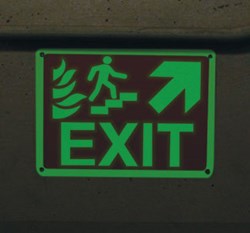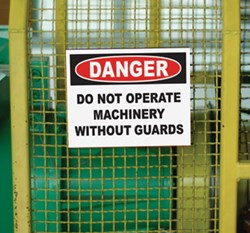Five Hidden Benefits of Safety Signage

Workplace safety has improved dramatically in recent decades-worker injuries and illnesses have decreased from 10.9 incidents per 100 workers in 1972 to three incidents per 100 workers in 2015-yet work remains to be done.
Safety signage can play a critical role in promoting safety and preventing injuries. Many of us associate safety signs with basic "Warning" and "Caution" labels, but they can go beyond the immediate warnings to include hidden benefits that keep workers safe in a variety of conditions. From wayfinding to PPE, here are five ways safety signage helps workers.
Wayfinding
At its core, wayfinding is designed to shuttle users from Point A to Point B. But users can also benefit from safety messages as they navigate facilities of all sizes. Here's how wayfinding can help users stay safe on the job.
- Steer clear of hazardous areas: Inform users of alternate routes when they might otherwise walk through an area littered with heavy-duty machinery, slippery surfaces, and other dangers.
- Avoid congestion: The more users crowd an area, the more likely they are to encounter (or create) hazards. Help users avoid congested areas, and use wayfinding to create safer routes.
- Help workers in emergencies: Wayfinding can send users to fire exits, outline emergency egress routes, and clearly point out fire extinguishers and other lifesaving equipment during emergencies.
Emergency Egress

OSHA has several rules and regulations for communicating emergency egress routes. The rules, found in 29 CFR 1910.37, explains how visual communication should lead employees to emergency exits.
- OSHA's standard for egress lays out several rules for clear "Exit" signs.
- Every exit must be visible and marked by a sign reading "Exit."
- Line-of-sight to an "Exit" sign must be visible at all times.
- The word "Exit" must be legible with lettering at least 6" (15.2 cm) high.
- Signs must be posted along the exit route, indicating access to the nearest exit, when a path isn't obvious.
- If a door can be mistaken for an exit, it must be marked "Not an Exit" (or with a similar message). It may also be identified by its actual use (such as a closet or restroom).
Arc Flash Safety Signage
OSHA's standard for electrical safety (29 CFR 1910.303) doesn't specifically mention arc flash labels, but the NFPA 70E Standard for Electrical Safety in the Workplace is a widely-accepted approach for keeping workers safe with clear visual communication.
The NFPA 70E standard includes requirements for electrical safety signage that, in addition to obvious warnings, can provide a wealth of information. Per the NFPA 70E standard, workplace electrical equipment should be labeled with the following:
- Nominal System Voltage: This identifies a piece of equipment or circuit's voltage class and communicates the potential shock hazard or degree of danger present.
- Arc Flash Boundary: This is the distance from the equipment at which an unprotected person would probably receive a second-degree burn in the event of an arc flash.
- PPE: This outlines the required PPE for safely working on the labeled equipment.
PPE Safety Signage
Safety signs don't just warn of hazards; they provide guidance on mitigating danger and promote safe work practices. Use signage to identify which types of PPE should be worn in a given area. Here are a few ideas for suggesting PPE, as well as scenarios when each might come in handy:
- Eye protection: Let workers know when dust, flying particles, or other hazards require workers to use eyewear-and outline which pieces of equipment should be used.
- Fall protection: Falls are the leading cause of death in the construction industry; use signs to warn workers of fall hazards, and communicate the need for proper fall protection.
- Ear protection: Warn of loud noise in an area, and require workers to use proper ear protection.
Equipment Maintenance Signage

Equipment requires routine maintenance, service, inspection, and repair. Here's how safety signage can help workers stay safe around equipment in need of service:
- Lockout/Tagout: Let employees know when certain machines require lockout/tagout (LO/TO) before servicing, and inform employees when a LO/TO procedure is being performed.
- Instructions: Remind employees to shut machines off before servicing, check fuel or oil levels, and read directions before starting work.
- Specific hazards: Warn employees about a machine's unique hazards (such as the dangers posed by moving parts, high air pressure, and oil pressure) so they can take the appropriate steps before starting work.
Safety Signage Resources
Print safety signage and labels suited to your facility's unique needs with DuraLabel industrial label and sign printers by Duralabel. Our printers accommodate various supplies, sizes, and types of signs, helping you comply with regulations while keeping workers safe.
Use your printer with more than 50 labeling supplies tailored to numerous application-specific uses. We carry supplies that stand up to abrasive and uneven conditions, shine in low-light areas, and resist common workplace hazards, including oil, grease, and solvents.
Complement your custom signs with our selection of premade safety signs, bearing numerous important messages and available in various materials and sizes.
Related Resources

OSHA Work Safety: A Right for Every Worker
How Can Workers Avoid Potential Injuries? The U.S. Bureau of Labor Statistics (BLS)shared its workplace ...
Read
Five Ways to Meet OSHA Requirements for Safety Signage
Every day, American workers service high-powered equipment, build and fix roads, and manufacture the goods we ...
Read
Print Electrical Safety Signs with a Thermal Transfer Printer
Why Are Electrical Safety Signs Essential for Compliance? Electrical safety is a major problem in modern ...
Read.png)





